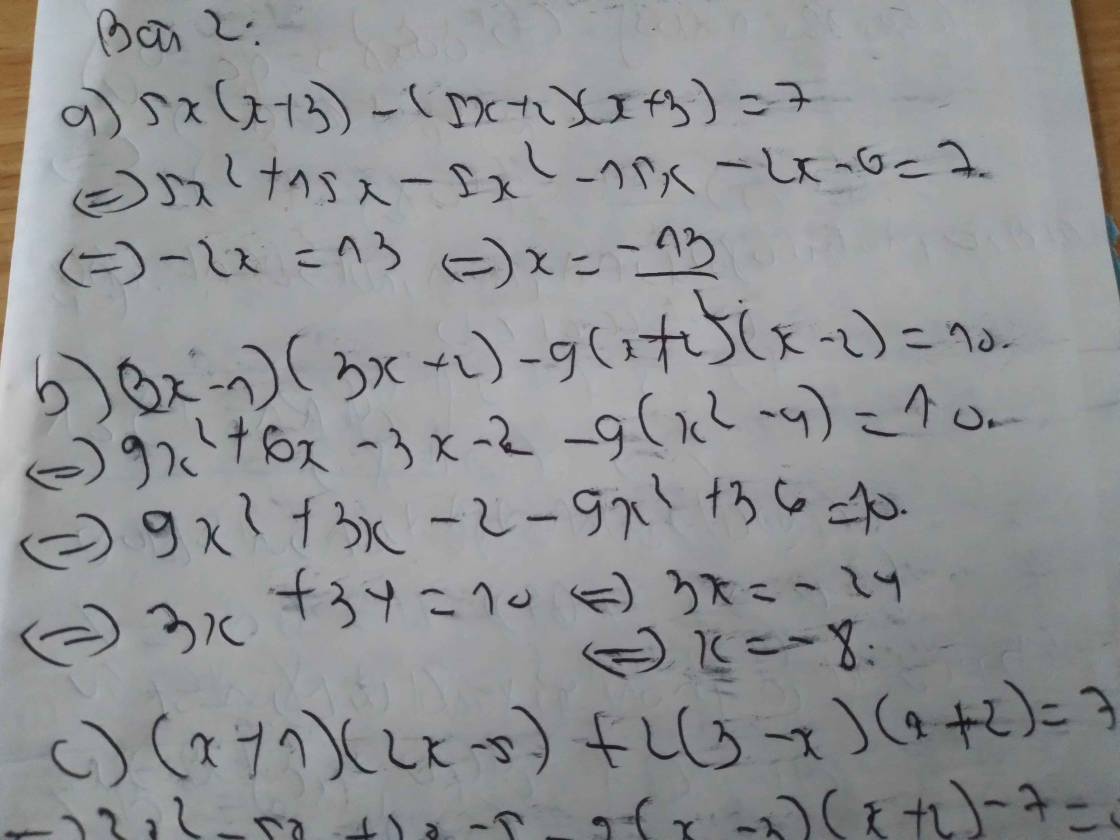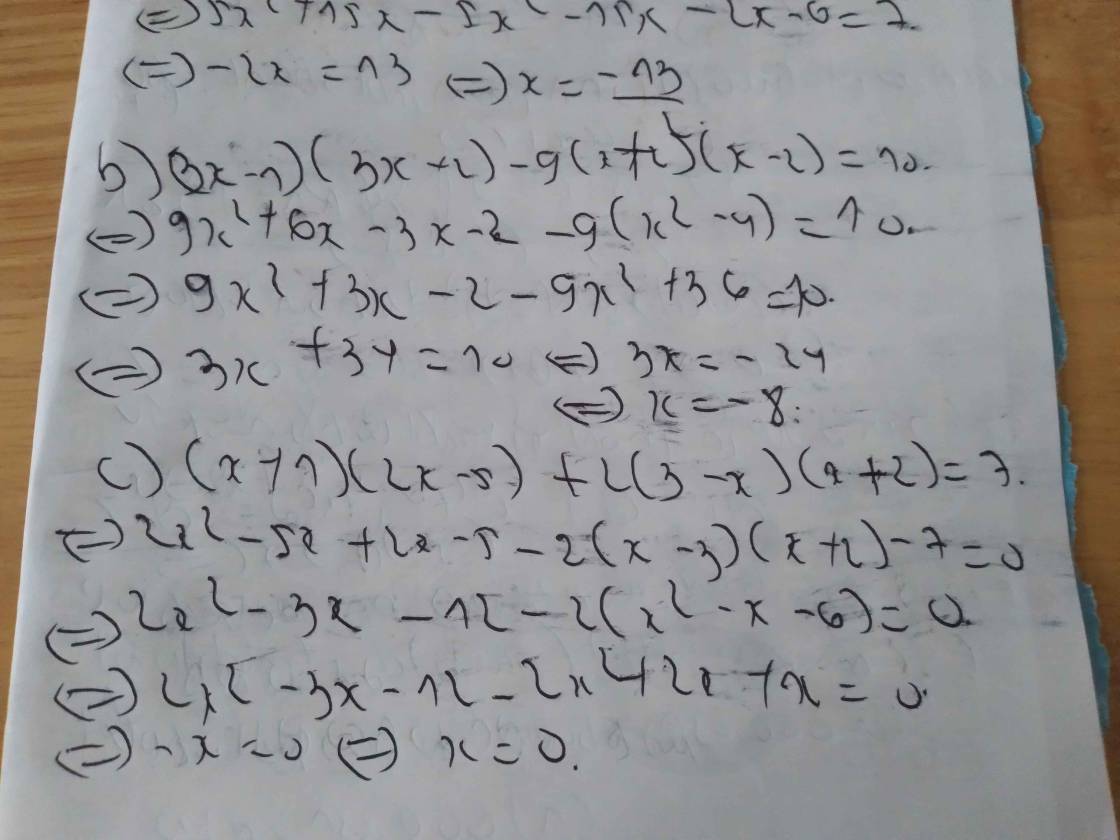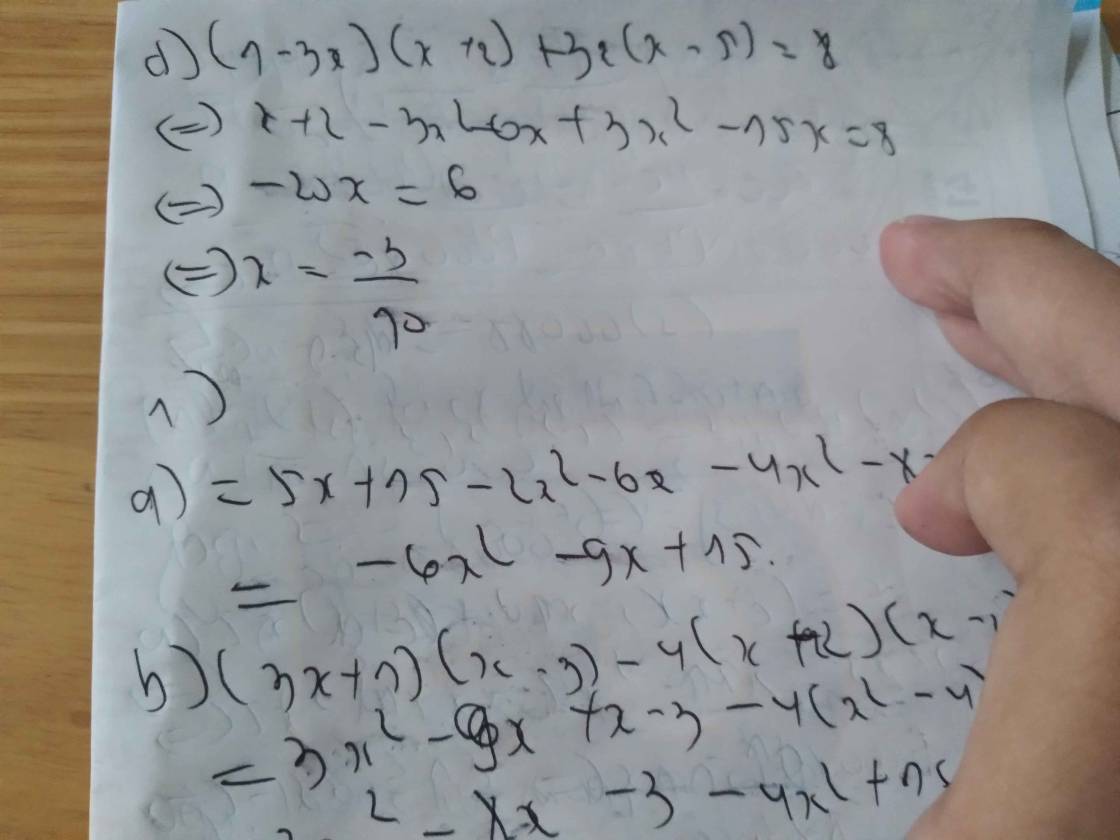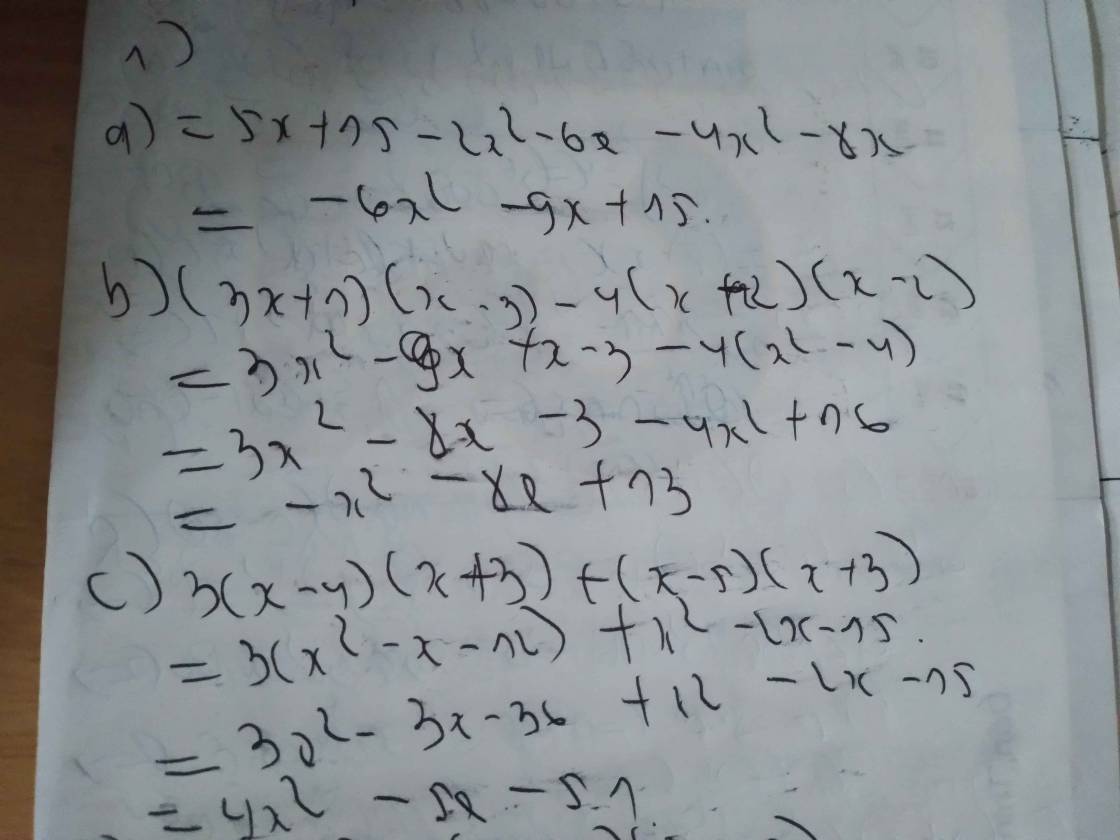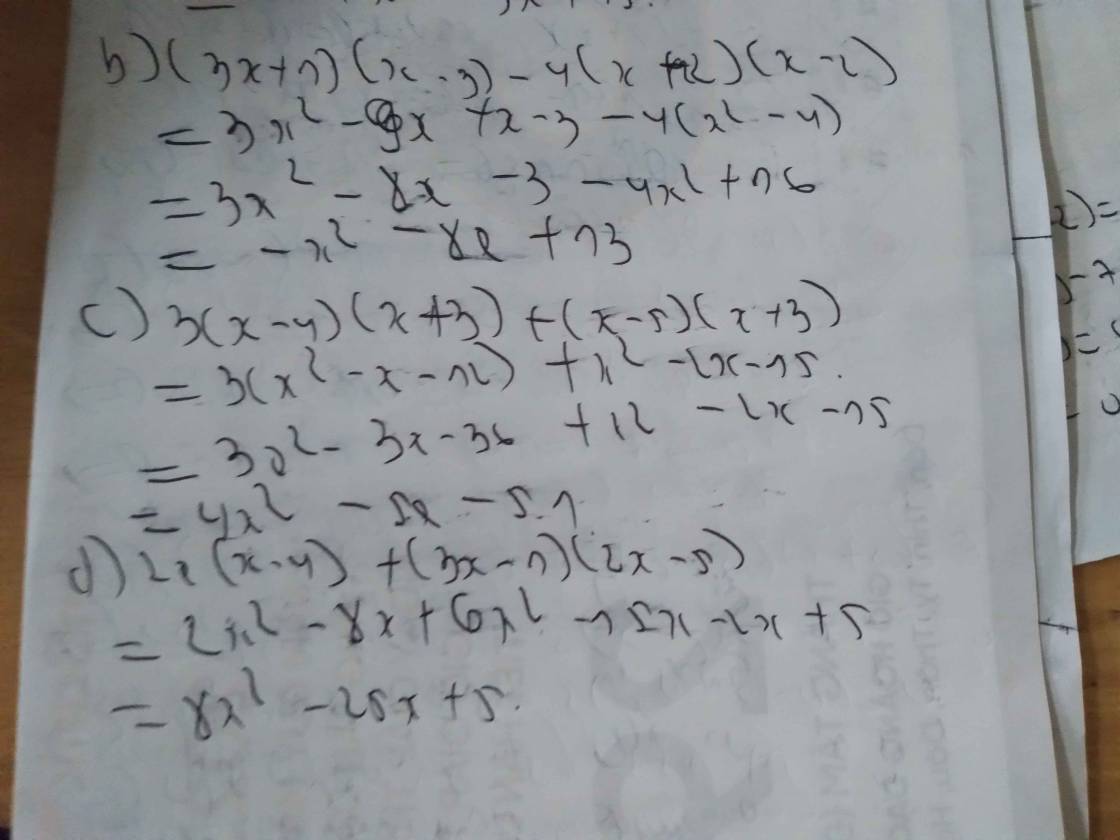(x+3)(x-2)+3x=4(x+3/4)

Những câu hỏi liên quan
Rút gọn :
1. (2x-5)(3x+1)-(x-3)^2+(2x+5)^2-(3x+1)^3
2. (2x-1)(2x+1)-3x-2)(2x+3)-(x-1)^3+(2x+3)^3
3. (x-2)(x^2+2x+4)-(3x-2)^3+(3x-4)^2
4. (7x-1)(8x+2)-(2x-7)^2-(x-4)^3-(3x+1)^3
5. (5x-1)(5x+1)-(x+3)(x^2-3x+9)-(2x+4)^2-(3x-4)^2+(2x-5)^3
6. (4x-1)(x+2)-(2x+5)^2-(3x-7)^2+(2x+3)^3=(3x-1)^3
1: \(=6x^2+2x-15x-5-x^2+6x-9+4x^2+20x+25-27x^3-27x^2-9x-1\)
=-27x^3-18x^2+4x+10
2: =4x^2-1-6x^2-9x+4x+6-x^3+3x^2-3x+1+8x^3+36x^2+54x+27
=7x^3+37x^2+46x+33
5:
\(=25x^2-1-x^3-27-4x^2-16x-16-9x^2+24x-16+\left(2x-5\right)^3\)
\(=8x^3-60x^2+150-125+12x^2-x^3+8x-60\)
=7x^3-48x^2+8x-35
Đúng 0
Bình luận (0)
tính:
f(x)+g(x)=\(-3x^2+x-1+x^4-x^3-x^2+3x^4+2x^3-x^4-x^2+x^3-x+5-5x^3+x^2+3x^4\)
f(x)+g(x)=-3x^2+x-1+x^4-x^3-x^2+3x^4+2x^3-x^4-x^2+x^3-x+5-5x^3+x^2+3x^4
=(-3x^2-x^2-x^2+x^2)+(x-x)-(1-5)+(x^4+3x^4-x^4+3x^4)-(x^3-2x^3-x^3+5x^3)
=-4x^2+4+6x^4+3x^3
Đúng 0
Bình luận (0)
p(x)=3x^2+7+2x^4-3x^2-4-5x+2x^3
Q(x)=-3x^3+2x^2-x^4+x+x^3+4x-2+5x^4
tính p(x) + Q(x)
Mình thu gọn 2 đa thức trước r mới cộng nhé
\(P\left(x\right)=3x^2+7+2x^4-3x^2-4-5x+2x^3\)
\(P\left(x\right)=\left(3x^2-3x^2\right)+\left(7-4\right)+2x^4-5x+2x^3\)
\(P\left(x\right)=2x^4+2x^3-5x+3\)
\(Q\left(x\right)=-3x^3+2x^2-x^4+x+x^3+4x-2+5x^4\)
\(Q\left(x\right)=\left(-3x^3+x^3\right)+2x^2+\left(-x^4+5x^4\right)+\left(x+4x\right)-2\)
\(Q\left(x\right)=-2x^3+4x^4+2x^2+5x-2\)
\(P\left(x\right)+Q\left(x\right)=2x^4+2x^3-5x+3-2x^3+4x^4+2x^2+5x-2\)
\(P\left(x\right)+Q\left(x\right)=\left(2x^4+4x^4\right)+\left(2x^3-2x^3\right)+\left(-5x+5x\right)+\left(3-2\right)+2x^2\)
\(P\left(x\right)+Q\left(x\right)=6x^4+1+2x^2\)
Đúng 0
Bình luận (0)
Bài 1:a) x (x^2 + 2) + 2x(1-dfrac{1}{2}x^2)4 b) (2x)^2 (x – 1) + x(x^2 + 4x) 40c) 3x(x – 2) – 3(x^2 – 3) 8d) 2x^2(4x^3 + 2x) + (x^2 – 2)(- 2x)^3 20Bài 2: P 3x(dfrac{2}{3}x^2 − 3x^4) + (3x)^2 (x^3 – 1) + (- 2x + 9)x^2 - 12
Đọc tiếp
Bài 1:
a) x (\(x^2\) + 2) + 2x\((1-\dfrac{1}{2}x^2)=4\)
b) (2x)\(^2\) (x – 1) + x(\(x^2\) + 4x) = 40
c) 3x(x – 2) – 3(\(x^2\) – 3) = 8
d) 2\(x^2\)(4\(x^3\) + 2x) + (\(x^2\) – 2)(- 2x)\(^3\) = 20
Bài 2:
P = 3x(\(\dfrac{2}{3}\)\(x^2\) − \(3x^4)\) + (3x)\(^2\) (\(x^3\) – 1) + (- 2x + 9)\(x^2\) - 12
Bài 2:
Ta có: \(P=3x\left(\dfrac{2}{3}x^2-3x^4\right)+9x^2\left(x^3-1\right)+x^2\left(-2x+9\right)-12\)
\(=2x^3-9x^5+9x^5-9x^2-2x^3+9x^2-12\)
=-12
Đúng 0
Bình luận (0)
Bài 1:
a: Ta có: \(x\left(x^2+2\right)+2x\left(1-\dfrac{1}{2}x^2\right)=4\)
\(\Leftrightarrow x^3+2x+2x-x^3=4\)
hay x=1
b: Ta có: \(4x^2\left(x-1\right)+x\left(x^2+4x\right)=40\)
\(\Leftrightarrow4x^3-4x^2+x^3+4x^2=40\)
\(\Leftrightarrow5x^3=40\)
hay x=2
c: Ta có: \(3x\left(x-2\right)-3\left(x^2-3\right)=8\)
\(\Leftrightarrow3x^2-6x-3x^2+9=8\)
\(\Leftrightarrow-6x=-1\)
hay \(x=\dfrac{1}{6}\)
Đúng 0
Bình luận (0)
Câu 1: Cho f(x) = −2x
4 + 3x
3 − 4x
2 + x − 7 và g(x) = −x
4 + 2x
3 − 3x
2 − x
3 + 3x
4 − 17. Khi
đó M(x) = f(x) + g(x)
Câu 2: Cho đa thức f(x) = −x
4 + 2x
3 − 5x
2 + 7x − 3 và g(x) = −3x
4 + 2x
3 − 7x + 5. Biết
M(x) = f(x) − g(x). Tính M(1) =?
mấy bn check hộ mk, nếu sai hãy chỉ ra giùm và sử lại nhé,
A=|x-2|+|2x-3|+|3x-4| ap dung BĐT|x|+|y|>=|x+y| |x-2|+|3x-4|=|x-2|+|4-3x|>=|x-2+4-3x|=|-2x-2| =)A= |x-2|+|4-3x|+|2x-3|>=|-2x+2|+|2x-3|>=|-2x+2+2x-3| =|-1|=1 dau = xay ra khi (x-2)(4-3x)>=0 va (-2x+2)(2x-3)>=0 =)4/3
+) Lỗi nhỏ: Sai ở chỗ: \(\left|x-2+4-3x\right|=\left|-2x-2\right|\)
+) Lỗi lớn: Dấu bằng xảy ra: \(\hept{\begin{cases}\left(x-2\right)\left(4-3x\right)\ge0\\\left(-2x+2\right)\left(2x-3\right)\ge0\end{cases}\Leftrightarrow}\hept{\begin{cases}\frac{4}{3}\le x\le2\\\frac{3}{2}\le x\le1\end{cases}}\Leftrightarrow\frac{3}{2}\le x\le1\)( làm tắt )
Nhưng mà thử vào chọn x= 1=> A = 3 > 1. Nên bài này sai.
Làm lại nhé!
A = | x - 2 | + | 2 x - 3 | + | 3 x - 4 |
= | x - 2 | + | 2 x - 3 | + 3 | x - 4/3 |
= | x -2 | + | x - 4/3 | + | 2x -3 | +2 | x - 4/3 |
= ( | 2 - x | + | x - 4/3 | ) + ( | 3 - 2x | + | 2x - 8/3 | )
\(\ge\)| 2 -x + x - 4/3 | + | 3 - 2x + 2x -8/3 |
= 2/3 + 1/3 = 1
Dấu "=" xảy ra <=> \(\hept{\begin{cases}\left(2-x\right)\left(x-\frac{4}{3}\right)\ge0\\\left(3-2x\right)\left(2x-\frac{8}{3}\right)\ge0\end{cases}\Leftrightarrow}\hept{\begin{cases}\frac{4}{3}\le x\le2\\\frac{4}{3}\le x\le\frac{3}{2}\end{cases}}\Leftrightarrow\frac{4}{3}\le x\le\frac{3}{2}\)
Timf `x`:
`(x - 2)/3 = (x + 1)/4`
`(x - 2) . 4 = (x + 1) . 3`
`<=> 4x - 8 = 3x + 3`
`<=> 4x - 3x = 3 + 8`
`<=> (4 - 3)x = 11`
`=> x = 11`
`(x - 2)/3 = (x + 1)/4`
`(x - 2) . 4 = (x + 1) . 3`
`<=> 4x - 8 = 3x + 3`
`<=> 4x - 3x = 3 + 8`
`<=> (4 - 3)x = 11`
`=> x = 11`
`=>` `x = 11`
Đúng 2
Bình luận (0)
Xem thêm câu trả lời
Tại sao ra đc bước : x^4 -3x^3 + 3x^2 -9x =0 này => 3x^4 -9x^3 + 9x^2 -27x=0 ( chuyển vế) => 3( x^4 -3x^3+3x^2 - 9x=0 => x^4 -3x^3 + 3x^2 -9x =0
Xem chi tiết
Đa thức P(x) = 2x^4 + 3x^2 − x^3 − 3x^4 − x^2 − 2x + 1 sau khi được thu gọn và sắp xếp theo bậc giảm dần của biến là:
A. P(x) = x^4 − x^3 + 2x^2 − 2x + 1
B.P(x) = −x^4 − x^3 + 3x^2 − 2x + 1
C. P(x) = −x^4 − x^3 + 2x^2 − 2x + 1
D. P(x) = x^4 − x^3 − 2x^2 − 2x + 1
Bài 1:Thực hiện phép tính
a,(5-2x)(x+3)-4x(x+2) b,(3x+1)(x-3)-4(x+2)(x-2)
c,3(x-4)(x+3)+(x-5)(x+3) d,2x(x-4)+(3x-1)(2x-5)
Bài 2:Tìm x biết
a,5x(x+3)-(5x+2)(x+3)=7
b,(3x-1)(3x+2)-9(x+2)(x-2)=10
c,(x+1)(2x-5)+2(3-x)(x+2)=7
d,(1-3x)(x+2)+3x(x-5)=8

























